STORMS
Lightning and Thunder, Calculate the distance of lightning, Fronts, Floods, Tornadoes, Hurricanes, Categories of Hurricanes, Blizzards
Mild precipitation and seasonal changes in weather can be easy for us to handle. However, severe weather can be a dangerous force, leaving destruction in its path.
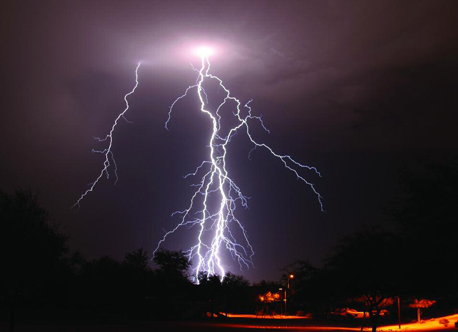 Heavy lightning can cause power to go out.
Heavy lightning can cause power to go out.
Lightning and Thunder
Boom! Have you ever heard the rumble of thunder and wondered why it happened? Lightning, created by the electricity in clouds, heats the air around it. The air moves so suddenly that it makes a crashing sound, like an explosion. Light travels much faster than sound. That is why we often hear the thunder after we have seen the lightning. The farther away the lightning is, the longer it will take to hear the thunder.
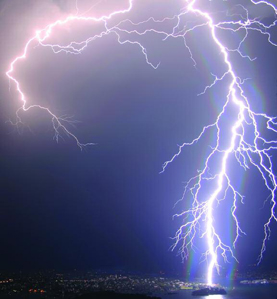 Thunder follows lightning.
Thunder follows lightning.
Calculate the distance of lightning
You can easily figure out about how far away lightning is from where you are. Light travels much faster than sound. You may see lightning right away, but the sound of the thunder travels five miles per second. So, when you see lightning, begin counting the seconds until you hear the thunder. “One-one thousand, two-one thousand, three-one thousand…Boom!” Stop counting when you hear the thunder. Then, divide your total seconds by five to determine about how many miles away the lightning is.
Fronts
Storms often occur when large bodies of air, called air masses, collide. Warm and cold air masses confront each other over the land. The place where they meet is called a front.
A cold front occurs when a cold air mass is pushing against a warm air mass. The opposite condition would be a warm front. A cold front moves quickly and plunges beneath warm air, often causing heavy rain or snow. These storms are usually followed by cooling temperatures. A warm front can also cause rain and temperature changes, but much more slowly.
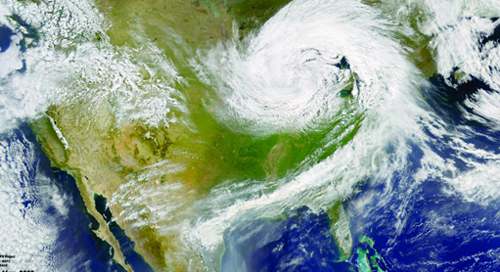 A satellite view of a frontal system moving over the United States.
A satellite view of a frontal system moving over the United States.
Floods
Heavy rains often bring the danger and destruction of flooding. Flash floods can occur in areas where creeks and other smaller waterways flow into larger rivers. After just a few hours of heavy rain, water levels can rise dramatically and thrust a powerful wall of water into surrounding towns.
Other floods, like tsunamis, can be predicted in advance. Tsunamis are giant waves caused by undersea events like Earthquakes, volcanoes, or landslides. Tsunamis, sometimes called tidal waves, can cause enormous damage to coastal areas.
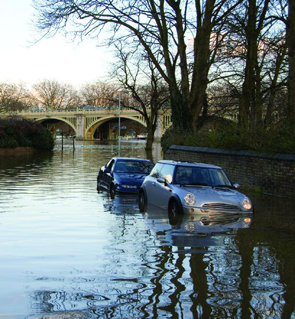 Severe flooding has submerged these cars.
Severe flooding has submerged these cars.
Tornadoes
Tornadoes are violent windstorms that occur when warm, moist air rises quickly toward cool air. Most tornadoes are funnel-shaped, but tornadoes can come in many different shapes and sizes. The rapidly swirling air occurs during a thunderstorm and stretches from the thunderstorm to the ground.
According to the National Oceanic and Atmospheric Association (NOAA), there are about 1,000 tornadoes reported in the United States each year. These tornadoes can leave a path of destruction over 1 mile (1.6 km) wide and 50 miles (80 km) long.
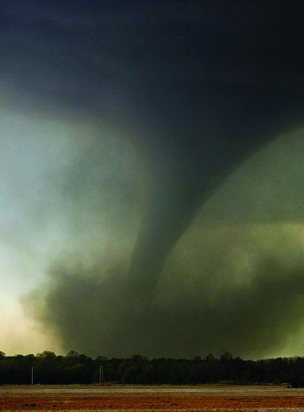 A tornado leaves a path of destruction.
A tornado leaves a path of destruction.
Hurricanes
Hurricanes are severe tropical storms that form over the ocean and often travel toward land, bringing strong winds and flooding. In some parts of the world, hurricanes are called typhoons or cyclones.
Hurricanes begin as tropical storms. Wind and rain rotates in a counterclockwise direction around the “eye” of the storm. When winds reach 74 miles (119 km) per hour, the tropical storm becomes a hurricane.
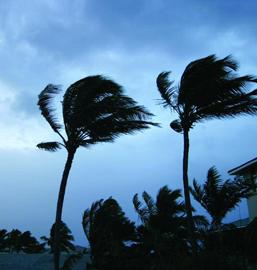 Hurricane force winds.
Hurricane force winds.
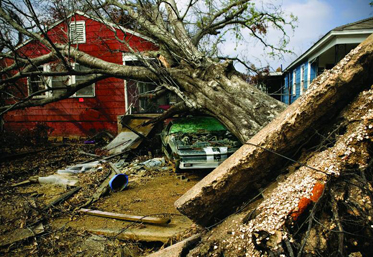 The aftermath of a hurricane.
The aftermath of a hurricane.
Hurricanes are classified by the strength of their winds.
Categories of Hurricanes
There are five categories of hurricanes, mainly determined by the strength of the winds and the amount of potential damage to structures. It is known as the Saffir-Simpson Scale.
Category 1: 74-95 mph (119-153 km/h) winds: very limited damage to structures
Category 2: 96-110 mph (154-177 km/h) winds: generally minor damage to structures
Category 3: 111-130 mph (178-209 km/h) winds: considerable damage to small structures
Category 4: 131-155 mph (210-250 km/h) winds: considerable damage to most structures
Category 5: winds over 156 mph (251 km/h): considerable damage to structures; devastating loss to small structures and mobile homes
Blizzards
Hurricanes are confined to tropical regions, but colder areas sometimes experience dangerous winter storms called blizzards. Strong winds and snowfall create a dangerous environment where people cannot see through the blowing snow, and “whiteout” conditions often occur.
Sometimes blizzards are not made of falling snow, but of snow that has been picked up from the ground by strong winds. These storms are called ground blizzards.
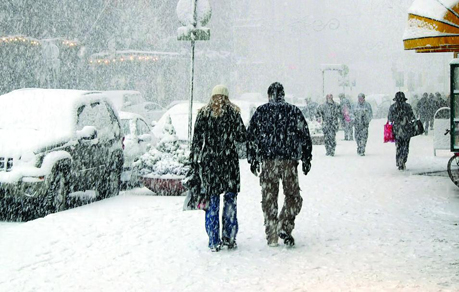 Heavy blizzards can cause whiteouts.
Heavy blizzards can cause whiteouts.
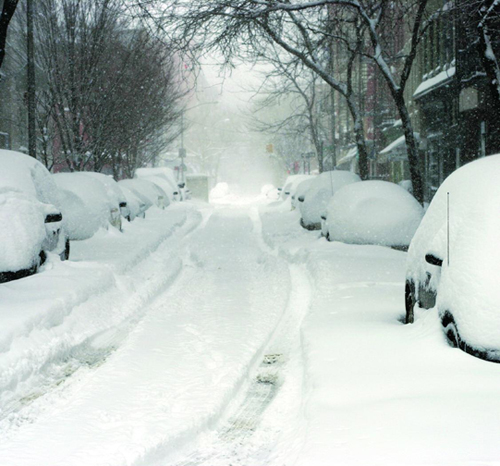 This street and all the cars parked on it are covered in deep snow due to a blizzard.
This street and all the cars parked on it are covered in deep snow due to a blizzard.
Additional topics
- WEATHER FORECASTING - Thermometers, Make your own barometer, Weather Maps
- SEASONS, CLIMATE, AND TEMPERATURE - Seasonal Change, Warm Rays
- Other Free Encyclopedias